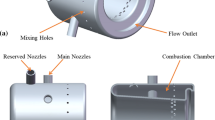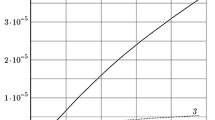Abstract
A new combustion concept, the so called RML, was investigated to validate its application as a gas turbine combustor for combustor outlet temperatures over 1973 K. The feasibility study of the RML combustor was conducted with zero dimensional combustion calculations. The emission characteristics of RQL, LEAN, EGR and RML combustors were compared. The calculation results showed that the RQL combustor has lower NOx emissions than the LEAN at high outlet temperature. NOx emissions of the RML combustor at equivalence ratio of the rich chamber of 2.0 can be reduced by 30 % compared with the EGR combustor, and lower than the RQL combustor at a combustor outlet temperature over 1973 K. However, the CO emissions of the RML combustor were higher than those of the LEAN and EGR combustors. Also, the possibility of applying the RML combustor to gas turbines was discussed considering residence time, equivalence ratio of the rich chamber and recirculation rate. Although further research to design and realize the proposed RML combustor is needed, this study verified that the RML concept can be successfully used in a gas turbine combustor.
Similar content being viewed by others
References
S. A. Mosier and R. M. Pierce, Advanced combustor systems for stationary gas turbine engines, phase I. Review and preliminary evaluation, Contract 68-02-2136, FR-11405, Final Report, U.S. Environmental Protection Agency, March, 1 (1980).
G. S. Samuelsen, J. Brouwer, M. A. Vardakas and J. D. Holdeman, Experimental and modeling investigation of the effect of air preheat on the formation of NOx in an RQL combustor, Heat Mass Transfer, 49 (2013) 219–231, DOI 10.1007/s00231-012-1080-0.
Y. Tanaka, M. Nose, M. Nakao, K. Saitoh, E. Ito and K. Tsukagoshi, Development of Low NOx Combustion System with EGR for 1700°C-class Gas Turbine, Mitsubishi Heavy Industries Technical Review, 50 (1) (March 2013).
A. H. Lefebvre and D. R. Ballal, Gas turbine combustion, Taylor and Francis Group, LLC, USA (2010).
M. M. Blomeyer, B. H. Krautkremer and D. K. Hennecke, Optimum mixing for a two-sided injection from opposing rows of staggered jets into a confined crossflow, American Society of Mechanical Engineers (Paper) (1996) 6.
A. S. Feitelberg and M. A. Lacey, The GE rich-quench-lean gas turbine combustor, Journal of Engineering for Gas Turbines and Power (1998).
D. M. Bachovchin, Rich -quench-lean combustion for multiple fuels, American Society of Mechanical Engineers (Paper) (1996) 7.
A. Cavaliere and M. de Joannon, Mild combustion, Progress in Energy and Combustion Science 30 329-366 (2004).
C. Morley, The Formation and Destruction of Hydrogen Cyanide from Atmospheric and Fuel Nitrogen in Rich Atmospheric-Pressure Flames, Combustion and Flame, 27 (1976) 189–204.
P. G. Nils I., L. S. Byggstøyl, B. F. Magnussen, P. Kilpinen and M. Hupa, A reduced mechanism for nitrogen chemistry in methane combustion, Symposium (International) on Combustion, Twenty-Fourth Symposium on Combustion, 24 (1) (1992) 889–898.
T. C. Lieuwen and V. Yang, Gas turbine emissions, New York, USA (2013).
Arghode Vaibhav K. and Gupta Ashwani K., Effect of flow field for colorless distributed combustion (CDC) for gas turbine combustion, Applied Energy, 57 (5) (2010) 1631–1640.
A. E. E. Khalil and A. K. Gupta, Impact of internal entrainment on high intensity distributed combustion, Applied Energy, 156 (2015) 241–250.
F. Guethe, D. Stankovic, F. Genin and K. Syed, Alstom Power, Baden, Switzerland Dieter Winkler University of Applied Sciences Northwestern Switzerland, Flue gas recirculation of the Alstom sequential gas turbine combustor tested at high pressure, Proceedings of ASME Turbo Expo 2011 GT2011 (2011).
S. E. Najim, A. C. Styles and N. Syred, Flame movement mechanisms and characteristics of gas fired cyclone combustors, Wales, UK (1981).
M. G. Zabetakis, Flammability characteristics of combustible gases and vapors, USA (1965).
H. F. Coward and G. W. Jones, Limits of flammability of gases and vapors, USA (1952).
GASEQ, A Chemical Equilibrium Program for Windows, http://www.c.morley.dsl.pipex.com (2013).
A. M. ElKady, A. Evulet, A. Brand, T. P. Ursin and A. Lynghjem, Application of Exhaust Gas Recirculation in a DLN F-Class Combustion System for Postcombustion Carbon Capture, Journal of Engineering for Gas Turbines and Power, 131 (2009).
G. P. Smith, D. M. Golden, M. Frenklach, N. W. Moriarty, B. Eiteneer, M. Goldenberg, C. T. Bowman, R. K. Hanson, S. Song, W. C. Gardiner, V. V. Lissianski and Z. Qin, GRI-Mech, http://www.me.berkeley.edu/gri_mech/.
A. E. E. Khalil and A. K. Gupta, Distributed swirl combustion for gas turbine application, Applied Energy, 88 (2011) 4898–4907.
M. Carona, M. Goethalsa, G. De Smedta, J. Berghmansa, S. Vliegenb and E. Van't Oostb, Pressure dependence of the auto-ignition temperature of methane/air mixtures, Journal of Hazardous Materials, 65 (3) 19 (1999) 233–244.
D. Konga, R. K. Eckhoff and A. F. Alfert, Auto-ignition of CH,/air, C3H8/air, CH&H,/air and CH,/CO,/air using a 1 l ignition bomb, Journal of Hazardous Materials, 40 (1995) 69–84.
L. Junwei and Z. Beijing, Experimental investigation on heat loss and combustion in methane/oxygen micro-tube combustor, Applied Thermal Engineering, 28 (2008) 707–716.
Author information
Authors and Affiliations
Corresponding author
Additional information
Recommended by Associate Editor Jeong Park
Tien Giap Van reveived his B.S. in Mechanical Engineering from Hanoi University of Science and Technology, Vietnam, in 2013. He is currently a Master student in University of Science and Technology, Korea and a student researcher in Korea Institute of Machinery & Materials (KIMM) in Daejeon, Korea. His research interests are in the area of design of gas turbine combustor, emission control and system analysis and computational fluid dynamic (CFD).
Jeong Jae Hwang received his B.S., M.S., and Ph.D. in Mechanical and Aerospace Engineering from Seoul National University, Korea, in 2007, 2009, and 2014. He is currently a Senior Researcher at Korea Institute of Machinery & Materials (KIMM) in Daejeon, Korea. His research interests are in the area of turbulent flames, combustion instabilities, and laser diagnostics.
Min Kuk Kim received his B.S. from Yonsei University in 2003 and Ph.D. in Mechanical Engineering from Seoul National University, Korea, in 2010. Dr. Kim is currently a Senior Researcher at Korea Institute of Machinery & Materials (KIMM) in Daejeon, Korea. His research interests are in the area of design of gas turbine combustor, emission control, laser diagnostics, and electricfield assisted combustion system.
Kook Young Ahn received his B.S. in Mechanical Engineering from Hanyang University in 1980 and Ph.D. in Mechanical Engineering from Advanced Institute of Science and Technology (KAIST), Korea, in 1994. Dr. Ahn is currently a Principal Researcher at Korea Institute of Machinery & Materials (KIMM) and a Professor at the University of Science and Technology (UST) in Daejeon, Korea. His research interests are in the area of the development of low NOx gas turbine combustor and fuel cell hybrid system for industrial applications.
Rights and permissions
About this article
Cite this article
Van, T.G., Hwang, J.J., Kim, M.K. et al. Feasibility study of ultra-low NOx Gas turbine combustor using the RML combustion concept. J Mech Sci Technol 30, 5749–5757 (2016). https://doi.org/10.1007/s12206-016-1145-y
Received:
Revised:
Accepted:
Published:
Issue Date:
DOI: https://doi.org/10.1007/s12206-016-1145-y




